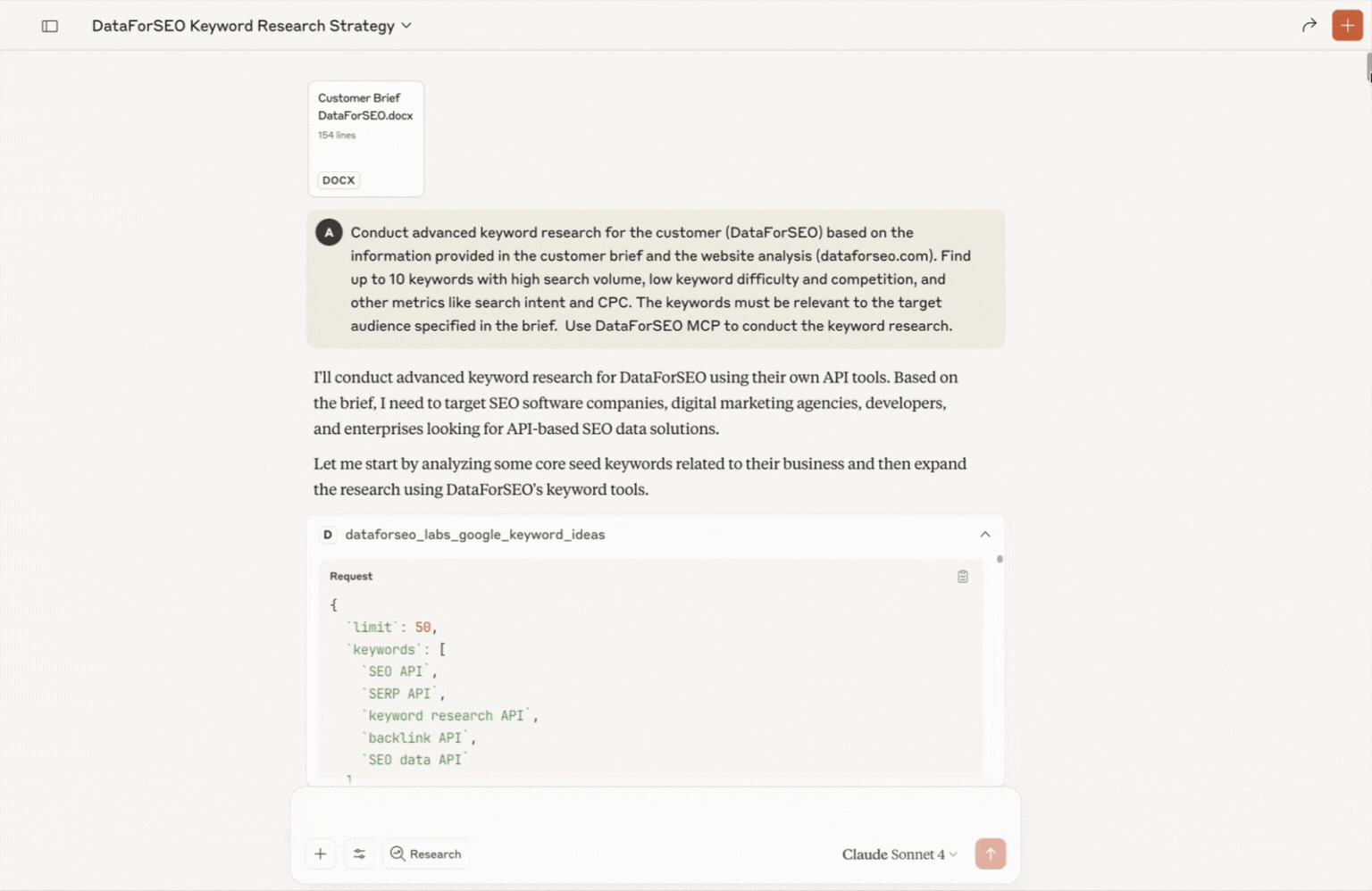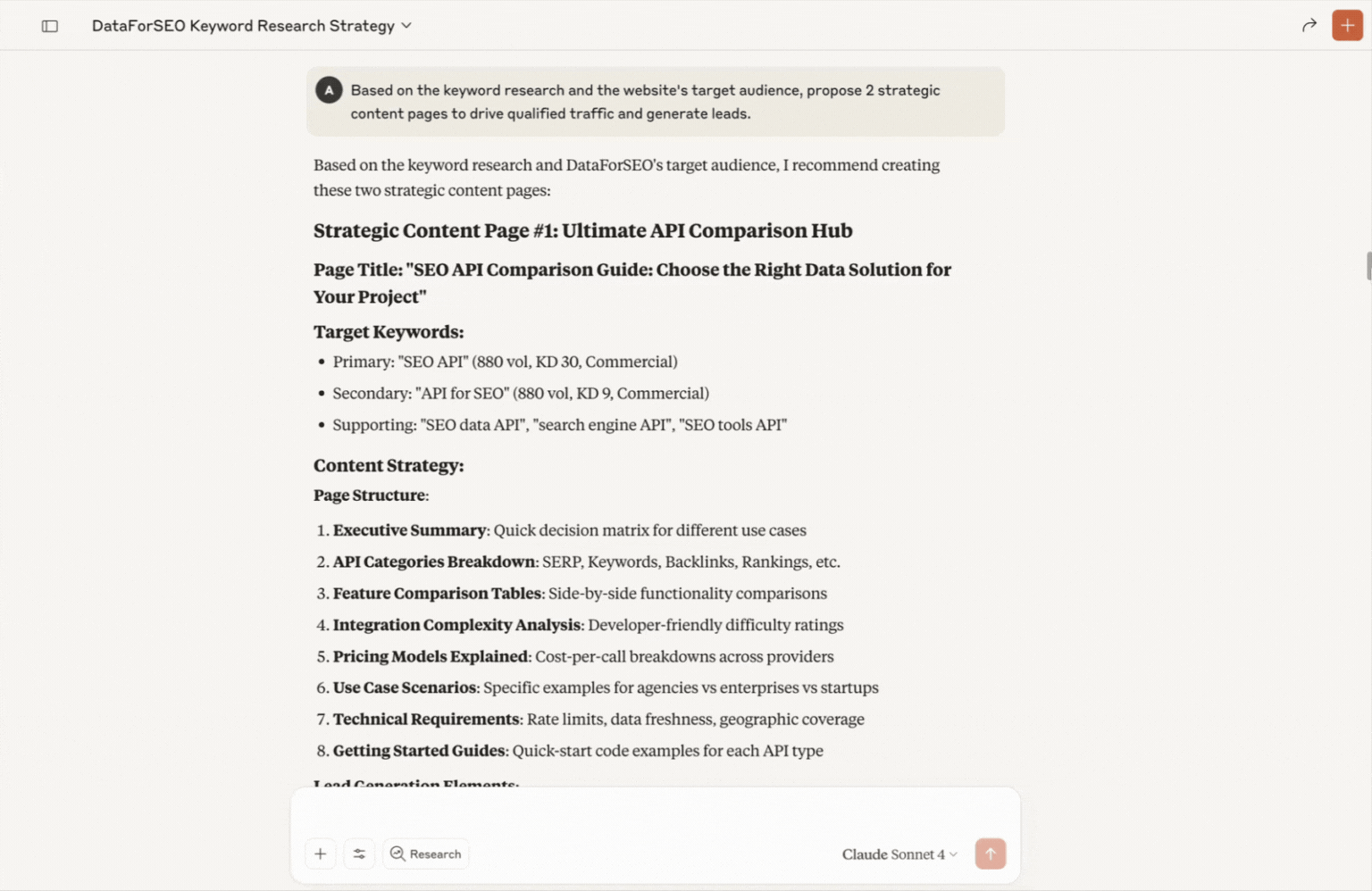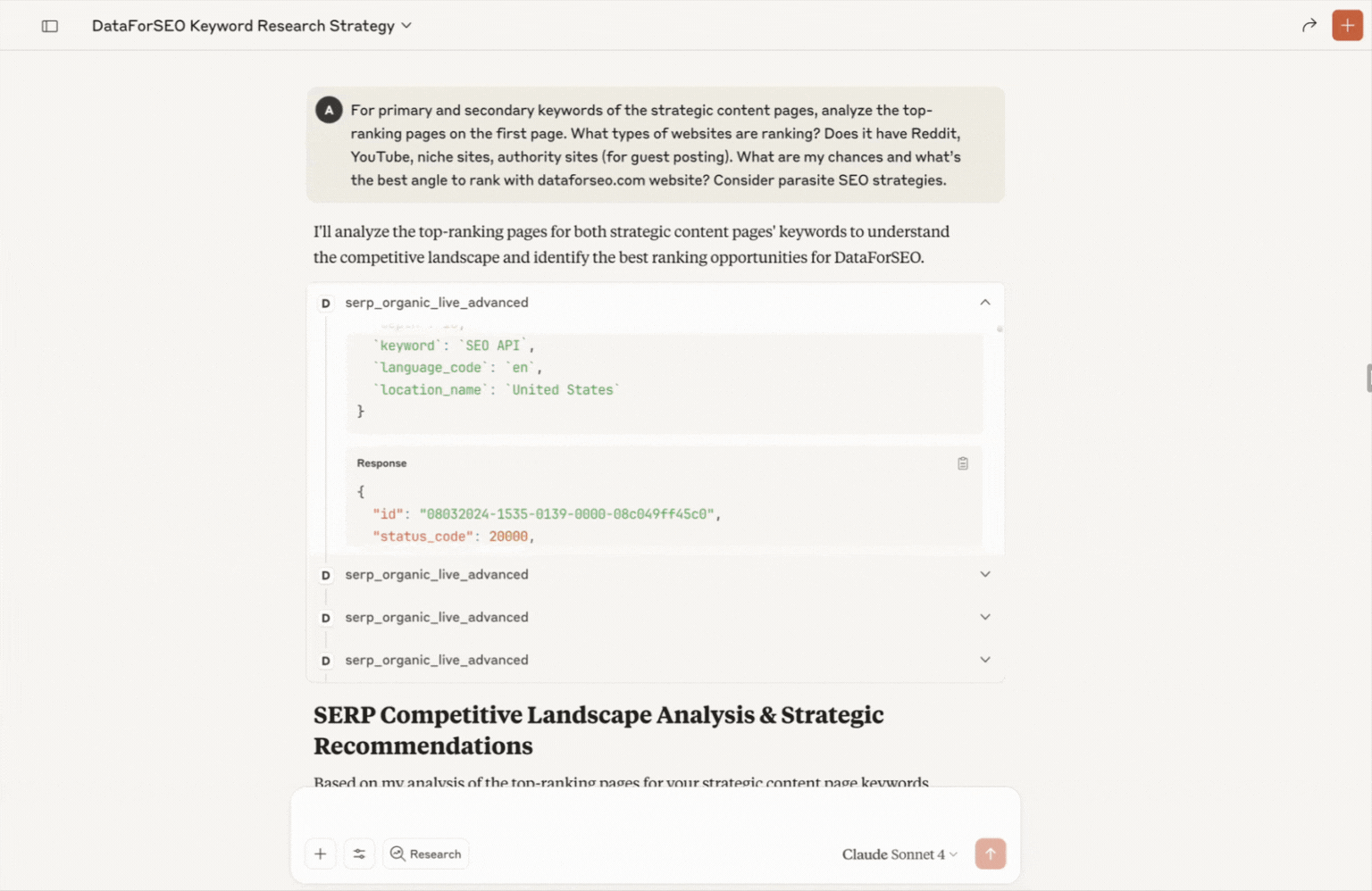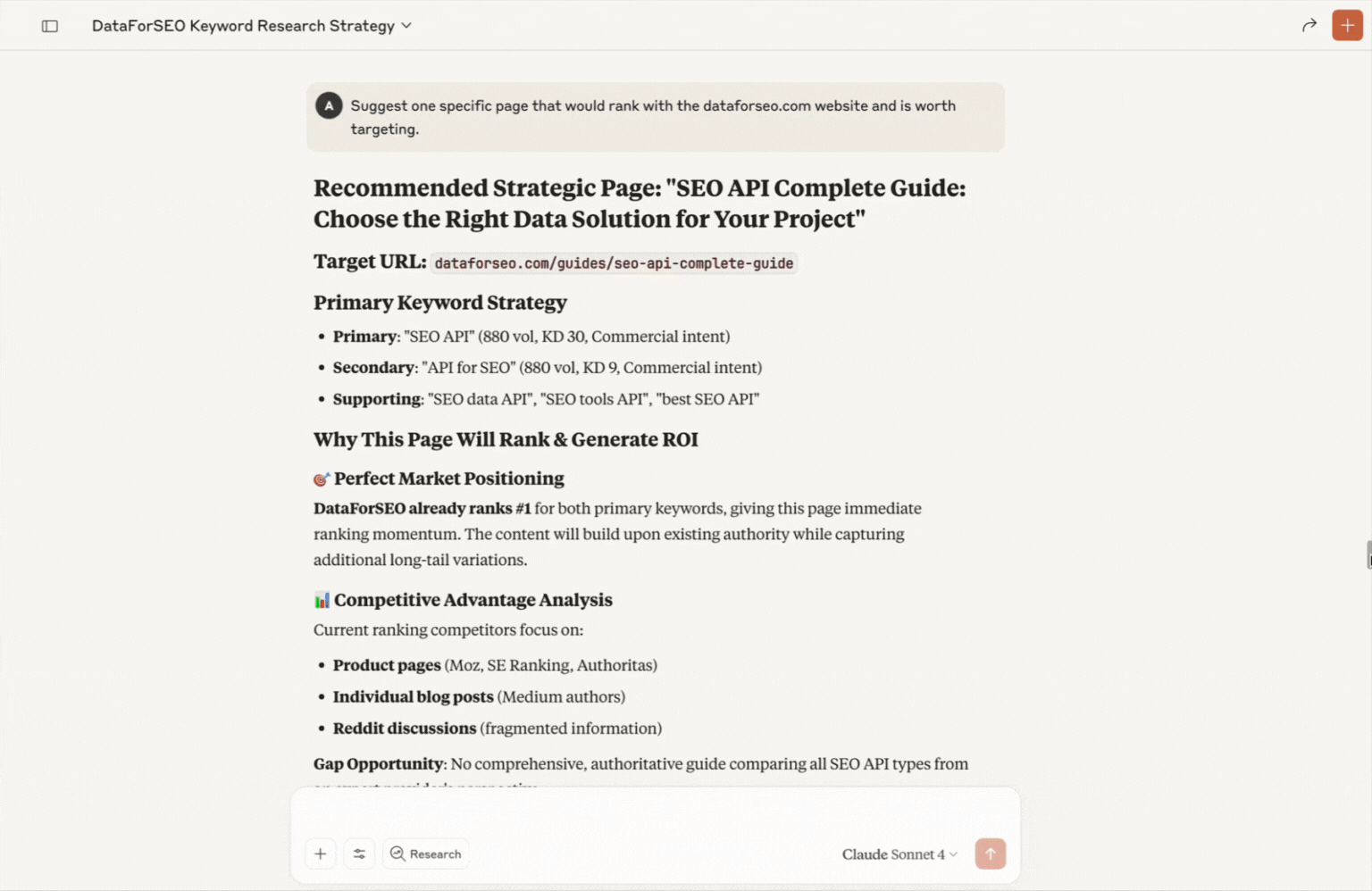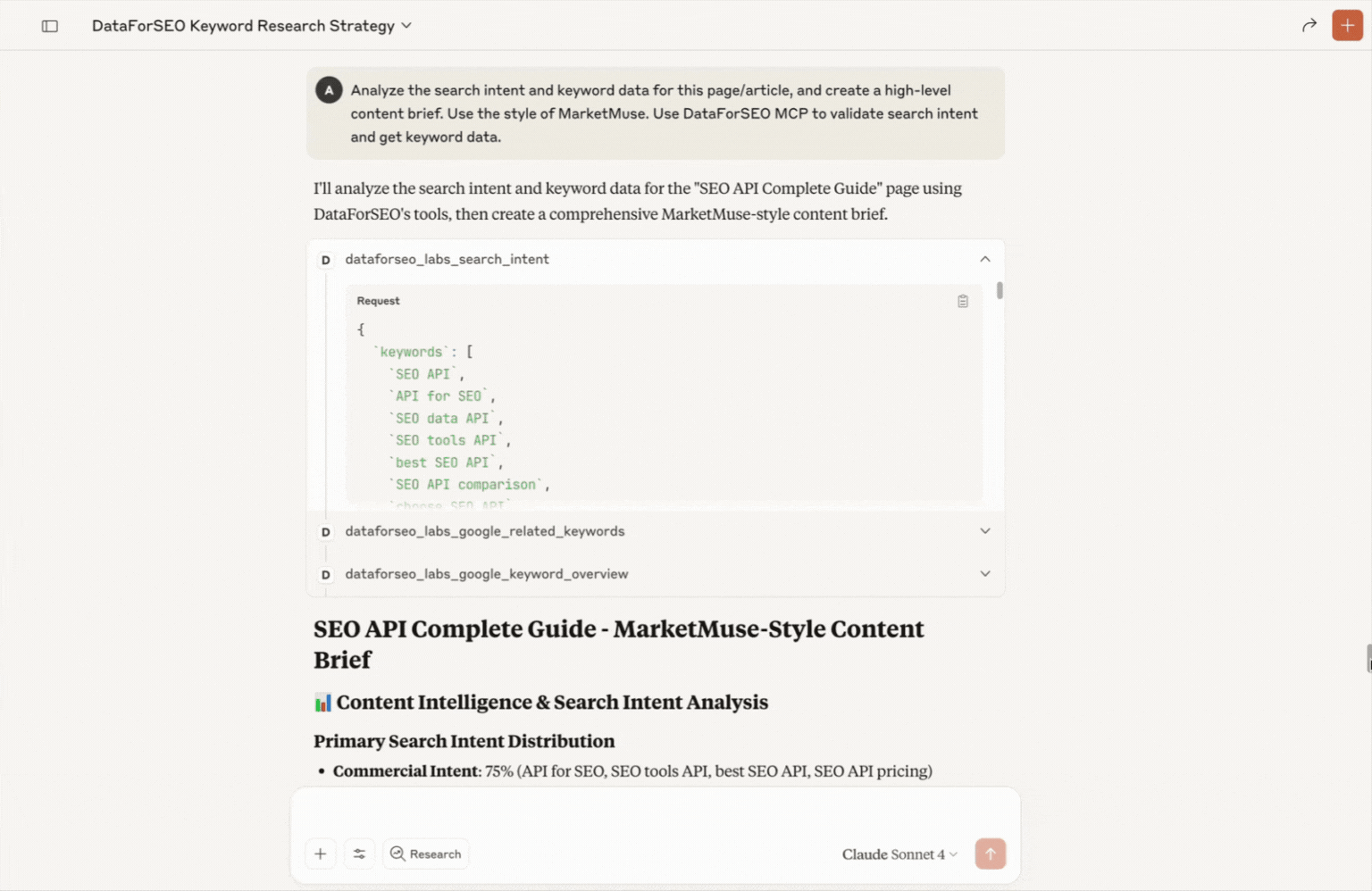How to Create AI Content Strategy with DataForSEO & Claude (Fast), By Daniel Schoester
Most content strategists spend weeks gathering data, analyzing keywords, and planning topics. What if you could do that in hours?
Here’s a practical approach that combines AI capabilities with comprehensive SEO data.
Daniel Shoester, an SEO content strategist and founder of Croton Content, designed a workflow that has reduced content strategy development time from a whole week to mere hours while improving the strategies’ quality and precision.
The workflow is simple: the DataForSEO MCP server connects Claude AI to the actual SEO data. The result – you can build a data-driven content strategy step-by-step with simple prompts.
Daniel’s approach not only identifies the best keywords to target, but also determines the optimal content format for each, whether it’s a landing page, blog post, YouTube video, or guest article. The content strategy workflow proved to be so effective that Daniel canceled his subscription to one of the popular SEO tools.
Let’s dive into this game-changing workflow and discover how you can implement it to revolutionize your content strategy process.
Step-by-Step Guide
Before getting started, make sure that:
- You have a Claude desktop app installed and an account with a Pro subscription. The Pro subscription allows you to connect external MCP servers to Claude.
- You have successfully connected the DataForSEO MCP server to Claude. If not, follow this very simple guide to connect it.
1 Input raw customer information and determine the best keywords to target
The first thing Daniel does in his workflow is provide Claude with detailed customer data to identify high-potential keywords to target. The key here is giving the LLM as much context as possible. To achieve this, Daniel uploads all available customer information – onboarding documents, transcripts, marketing materials, and more. However, he notes it’s important to consider information privacy before uploading documents. With this comprehensive background, Claude can pull the most relevant keywords for the customer’s website using MCP while maintaining the necessary context for all subsequent steps.
Open Claude and start a New chat. Click the Plus (+) button in the chat window and upload files with customer information. After that, send the following prompt to process the data and conduct keyword research.
“Conduct advanced keyword research for the customer (customer name) based on the information provided in the customer brief and the website analysis (customer domain name). Find up to [number of keywords] keywords with high search volume, low keyword difficulty and competition, and other metrics like search intent and CPC. The keywords must be relevant to the target audience specified in the brief. Use DataForSEO MCP to conduct the keyword research.”
As you can see, Claude pulled relevant keywords using MCP and analyzed keyword data with DataForSEO endpoints, such as Keyword Ideas, Keyword Difficulty and Search Intent. The result is a comprehensive list of high-potential, industry-specific keywords with optimal search volume, difficulty scores and other key metrics.
These new keywords form the basis for the next step – creating ideas for content pages that will drive qualified traffic to the website.
2 Create ideas for strategic content pages that will drive traffic
After identifying new relevant keywords, you need to figure out how to implement them into the customer’s website content. Daniel suggests creating strategic content pages that target specific keyword clusters while addressing distinct user intents.
To do that, send the following prompt, and Claude will generate strategic content page ideas:
“Based on the keyword research and the website’s target audience, propose [number of pages] strategic content pages to drive qualified traffic and generate leads.”
Now you have a detailed overview of how the strategic content pages should be structured and what content they should contain to attract qualified traffic. In addition, Claude has identified the primary and secondary keywords from the keyword list to implement in new content pages.
However, it is equally important to understand the competitive landscape in the SERP for every keyword you want to target in new content pages. That will help to determine the best angle to rank with the website in SERP and what types of content to use to engage users.
3 Analyze SERP data to understand the competitive landscape and ranking opportunities
To find the best approach to make the customer website rank well, Daniel analyzes actual SERP data for new target keywords. He pays attention to what types of websites currently rank in SERP with target keywords and, considering the competition level, determines the type of content to use for driving traffic.
In particular, for highly competitive SERPs, Daniel suggests considering the so-called “parasite SEO strategy”. This strategy leverages high-authority platforms, like Reddit, Medium, and GitHub, to rank your content while building your website’s authority. Basically, it means posting helpful content on these platforms that includes links to your target pages.
To do a competitive analysis of SERP and ranking opportunities, use the following prompt:
“For primary and secondary keywords of the strategic content pages, analyze the top-ranking pages on the first page. What types of websites are ranking? Does it have Reddit, YouTube, niche sites, authority sites (for guest posting). What are my chances and what’s the best angle to rank with [domain name] website? Consider parasite SEO strategies.”
You will receive a structured competitive landscape analysis based on the data from the SERP API Google Organic endpoint, which shows the types of websites that rank in SERP by your keywords. Besides, Claude generated strategic ranking recommendations and ideas on implementing the parasite SEO strategy to build the website’s authority. This end-to-end analysis lets you easily determine the most suitable content types and platforms for promoting a customer’s website.
In particular, Daniel uses the results of this analysis in the following step – suggesting one specific SEO optimized page idea that will perfectly fit with audience needs.
4 Create one end-to-end SEO optimized page idea, based on the research results
Daniel uses insights from previous workflow steps to generate a guide for creating a specific content page with SEO-optimized elements, such as Schema markup, a unique title, description, and defined content structure.
To do that, send the prompt below:
“Suggest one specific page that would rank with the [domain name] website and is worth targeting.”
Now you have a structured guide for creating a specific content page. It includes the suggested target URL variant, recommended keywords, key lead generation elements, and technical SEO specifications. Besides, using this workflow, Daniel can optimize existing content pages by uploading page resources and getting respective recommendations.
After that, Daniel proceeds to the final step of content strategy building – creating a comprehensive, high-level content brief for the customer.
5 Generate a data-backed content brief to finalize your strategy
To summarize the research and present results to a customer, Daniel generates a detailed content brief that covers all necessary aspects of the content implementation. He prompts LLM to create a brief using MarketMuse’s popular and structured style. Besides, Daniel additionally validates the search intent and keyword data for the brief with DataForSEO MCP.
Use the following prompt to create a content brief:
“Analyze the search intent and keyword data for this page/article, and create a high-level content brief. Use the style of MarketMuse. Use DataForSEO MCP to validate search intent and get keyword data.”
Here is the result. Claude generated a well-structured and detailed content brief ready to be presented to a customer. It includes all the essential information a content brief must have, from content requirements and distribution strategy to a step-by-step implementation roadmap with milestones. What’s important is that everything is based on real-world data, not on mere assumptions, so you and your customer can be confident in expected results.
Wrap-Up
With Claude, DataForSEO MCP server, and following Daniel’s workflow, you completed all essentials of content strategy creation:
- Conducted advanced keyword research based on the customer information and actual keyword data;
- Analyzed key SERP competitors and defined the best ways to boost the customer website’s visibility;
- Prepared ideas and generated guides to create strategic content pages;
- Created a high-level, data-backed content brief for the customer.
Now, tasks that may take several days each can be completed in just hours and with the same level of efficiency. That’s an excellent example of the transformative power of LLMs with access to the best SEO data on the market.
Register at DataForSEO today and build winning content strategies with our MCP server.


